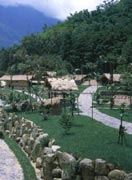The Formosan Aboriginal Culture Village  "Formosan" is a local name among the Taiwan people for the nine Gaoshan ethnic groups°™Yamei Nationality, Amei Nationality, Taiya Nationality, Saixia Nationality, Zou Nationality, Bunong Nationality, Beinan Nationality, Lukai Nationality and Paiwan Nationality, which keep their traditional culture well. The Pingpu people are not included. "Formosan" is a local name among the Taiwan people for the nine Gaoshan ethnic groups°™Yamei Nationality, Amei Nationality, Taiya Nationality, Saixia Nationality, Zou Nationality, Bunong Nationality, Beinan Nationality, Lukai Nationality and Paiwan Nationality, which keep their traditional culture well. The Pingpu people are not included.
Similar to the Chinese Ethnic Culture Park in Beijing and the Nationalities Village in Kunming of Southwest China's Yunnan Province, the Formosan Aboriginal Culture Village built in Taiwan is also a large-scale cultural facility, which combines collection, protection, propagation and exhibition of the traditional national culture, as well as sightseeing.
The Formosan Aboriginal Culture Village lies by the Sun-moon Lake of Nantou County, south of Taitan, covering an area of 62 hectares. The overall arrangement relies mainly on the civilian houses of the traditional local-style villages, embellished with some modern facilities imitating the European building and art sculpture style, such as "Shuishalianli Palace" and "Laser Music Fountain". In the village, the culture, entertainment and life facilities, such as "Mountain Region Cultural Relics Museum," performance hall, opera theatre, mountain-viewing building and restaurants, are all available. Among the buildings there has been adorned with lawn and gardens, simple, refined, but not losing the flavor of the times.
Referring to a survey by the Japanese scholar Qianqianyan in 1930, the residential building groups in the Formosan Aboriginal Culture Village recover to its original appearance, keep and reflect its traditional characteristics. The village sight can be divided into nine smaller villages by different clans. With its unique style, each village has an organic whole of its own. Some buildings are covered with couch grass and take slabstone as the roof beam; Some dig caves as rooms and build stones as walls; Some put up wood as the post and weave bamboo as the buildings; Some carve the beams and paint the rafter; Some are simple and refined. Around these buildings are some static objects and dynamic performances, possessing rich academic and visual value and showing the visitors the clan organization, living facilities, religions and sacrifices offering, wedding and funeral customs, etiquette and taboo, etc.
Tracing the History of the Gaoshans <<
Story of the"Sculpture of Righteous Man Wu Feng" >>
|